Abstract
Upper Cretaceous carbonate rocks of the Sarvak Formation are among the most important hydrocarbon reservoirs of the Middle East. This paper summarizes the depositional history, diagenetic alteration, and geochemistry of this formation in south and southwest Iran. The combined effects of tectonic activities and the paleoclimate had remarkable control over the depositional–diagenetic evolution of this formation. Large changes in facies types, their frequency, and thickness were recorded across the study area and attributed to the tectonic activities. The complex diagenetic history of this formation includes minor marine, intensive meteoric, and burial diagenesis. Two pronounced paleoexposure events were recorded at the Cenomanian–Turonian boundary (CT-ES) and the middle Turonian (mT-ES), which are associated with remarkable changes in facies and diagenetic characteristics and special geochemical trends. Elemental (Mg, Fe, Rb, Mn, Sr), isotopic (carbon, oxygen), and 87Sr/86Sr ratios provide useful tools for delineating the paleoexposure surfaces, their associated diagenetic alterations, and chemo-sequence stratigraphic interpretation. Variable exposure durations resulted in immature to over-matured karstified profiles below the CT-ES and mT-ES, respectively. Meteorically dissolved rudist-dominated facies provided the best reservoir zone of the Sarvak Fm. in the regressive systems tract of the Cenomanian sequence, just below the CT-ES. Microporous and dolomitized mud-dominated facies formed the second important reservoir intervals, especially within the transgressive systems tracts. The results of this study revealed that the reservoir characteristics of the Sarvak Fm. were considerably controlled by paleoexposure events and, therefore, it can be considered as a typical paleokarst hydrocarbon reservoir in Iran.
1. Introduction
Upper Cretaceous carbonate successions (Sarvak and Ilam formations) are important petroliferous rock units in the Middle East, including the Zagros Basin [1,2,3]. They contain large volumes of hydrocarbons in several giant to supergiant oil and gas fields in SW Iran, including the Dezful Embayment (e.g., Ahwaz, Marun, Gachsaran, Rag-e-Sefid, Abteymour, Mansuri, etc.), the Abadan Plain (e.g., Azadegan, Jufair, Yadavaran, Darquain, Kushk, etc.), the Interior Fars (e.g., Sarvestan and Saadat Abad), and the Persian Gulf (e.g., Sirri, Hendijan, Bahregansar, Binak) (Figure 1). The Sarvak Formation is the second most important oil reservoir in Iran, after the Oligocene–Miocene Asmari Formation.
Since 2012, these reservoir rocks have been the subject of several studies focusing on their sedimentological [1,4,5,6,7,8,9,10], palaeontological [11,12,13], geochemical [2,14,15,16,17,18,19], and petrophysical [20,21,22] characteristics. Most of these studies were conducted by the author of this paper and his colleagues at the University of Tehran.
This study aims to bring the main results of all the previous studies together and present an overview of the depositional settings, diagenetic alterations, and geochemical compositions of Upper Cretaceous shallow-marine carbonates in the Zagros Basin. This large-scale synopsis will help to better understand the controlling factors of the depositional–diagenetic evolution of the Zagros Basin and, on a wider scale, the Middle East during the Late Cretaceous. It will also be useful for the exploration and development planning of hydrocarbon fields supplied by Upper Cretaceous reservoirs in various parts of the Zagros Basin.
2. Geological Setting and Stratigraphy
The Late Cretaceous (Cenomanian–Turonian: C–T) was a time of remarkable tectonic activity on the NE margin of the Arabian Plate (AP,) including the Zagros Basin [23,24,25]. At that time, a previous passive tectonic margin of the AP evolved into an active margin, following the initiation of the Neo-Tethys subduction beneath the Central Iranian Plate (CIP) at the end of the Cenomanian [16,24,26]. This huge change in the tectonic regime resulted in highly variable depositional settings for the C–T carbonates throughout the Zagros Basin [7,12].
The Cretaceous was the time of the highest eustatic sea level and, consequently, the maximum development of shallow-marine carbonate platforms over the continental plate margins, such as the AP [27]. During the C–T, the Zagros Basin was part of the NE margin of the AP, located at paleolatitudes of 0–5° north of the equator [28,29] (Figure 1). As a result, C–T carbonates were deposited under a warm and humid (tropical) climate [13,18,19]. The combined effects of tectonic activities, eustatic sea level changes, and paleoclimatic condition resulted in an intense and highly variable diagenetic evolution of the sediments deposited in various parts of the Zagros Basin [5,9]. Such remarkable changes in depositional–diagenetic characteristics are reflected by conspicuous variations in the geochemical compositions of C–T carbonates [2,18,19,30].
C–T carbonate rocks from the Zagros Basin have been included into the Sarvak Formation [31]. Similar rocks from the adjacent areas have been included into the Mishrif Formation in Iraq, UAE, and Qatar [3], the Derdere Formation (Mardin Group) in Turkey [32,33], and the Natih Formation in Oman [29] (Figure 2). The Sarvak Fm. is dominantly composed of rudist-dominated and foraminiferal limestone and dolomitic to argillaceous limestone. The Sarvak Formation is underlain by the Kazhdumi Fm. (shale and marl) along a sharp contact and overlain by the Ilam, Surgah, Laffan, or Gurpi formations with a disconformable boundary (Figure 2). In this study, the lower part of the Ilam Fm. is also included for delineating the Sarvak–Ilam boundary that corresponds to the mid-Turonian disconformity (abbreviated as mT-ES).
3. Materials and Methods
The dataset in this study includes results of thin-section, scanning electron microscope (SEM), X-ray diffraction (XRD), carbon and oxygen isotope, trace element, and strontium isotope analyses of the Sarvak Fm. and the lower parts of the Ilam Fm. from 23 wells studied in 14 oilfields located in various parts of the Zagros Basin, including the Dezful Embayment, Abadan Plain, Fars, and the Persian Gulf (Table 1). Macroscopic and microscopic petrographic studies of 3186 m of cores and 7452 thin sections are integrated with the results of SEM (147 samples) and XRD (116 samples) analyses and geochemical analysis of 701 samples for stable isotopes (C&O), 490 samples for elemental analysis, and 274 samples for strontium isotope measurements. Geochemical data from the Dezful Embayment and Abadan Plain were previously published [2,16,18,19], and the rest of the data in this study are new.

Table 1.
Summary of datasets used in this study.
The textural classification schemes of Dunham [34] and Embry and Klovan [35] were used along with the standard microfacies model of Flügel [36] for the identification of sedimentary facies and the interpretation of the depositional environment. SEM analysis was implemented using the MIRA3 TESCAN apparatus at the Razi Metallurgical Research Center, Tehran, Iran. The geochemical samples were drilled from the micrite, cements, unaltered shell fragments, and whole rocks using a 0.5 mm tungsten carbide bit under a binocular microscope. The carbon and oxygen isotopic measurements were conducted at the stable isotope laboratory of the Institute of Geology, Leibniz University Hannover, Germany, using a Thermo Fisher Scientific Gas bench II mass spectrometer. The external reproducibility values were ≤0.06‰ for δ13C and ± 0.08‰ for δ18O (see [17] for the isotopic values of standards).
Strontium isotope composition was analyzed using a Thermo Scientific TRITON thermal ionization mass spectrometer (TIMS) at the Boston TIMS Facility, USA. The 87Sr/86Sr values of all samples were corrected for in situ Rb decay incorporated by clay minerals [37] using the equations by Faure and Mensing [38]. Elemental concentrations were measured using the Analytik Jena ICP-OES device in the Central Lab of Arak University and using atomic absorption (AA) and inductively coupled plasma (ICP) spectrometers at the University of Tehran.
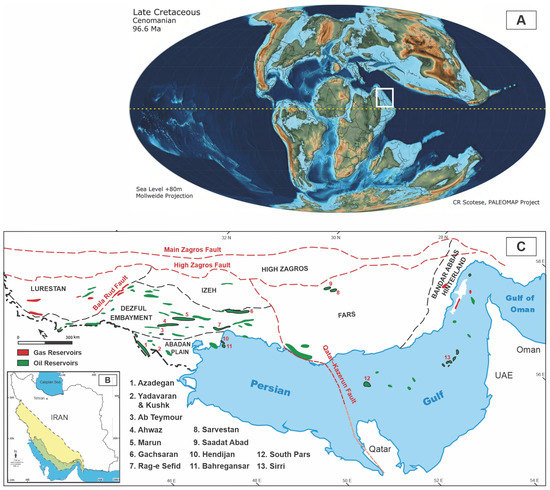
Figure 1.
(A) Paleogeographic map of the world during the Late Cretaceous (modified after [39]). Study area on the northeastern margin of the Arabian Plate is marked by the white rectangle on this map. (B) General map of Iran (inset) and (C) location map of the studied fields in the Zagros and Persian Gulf basins (modified after [31]).

Figure 2.
Stratigraphic chart of Cretaceous in Iran and neighboring countries (modified after petroleum geo-service; http://www.pgs.com; accessed on 13 August 2023). The Sarvak Formation and its stratigraphic equivalents are marked by the red box on this column.
4. Results
4.1. Microfacies
Microscopic petrographic analyses indicate that the Sarvak Fm. is composed of eight microfacies types in various parts of the Zagros Basin. The general characteristics of these facies are presented in Table 2. Representative photomicrographs of the microfacies are summarized in Figure 3. Short descriptions of the facies are presented below.

Table 2.
Summary of facies characteristics of the Sarvak Formation in the Zagros Basin.
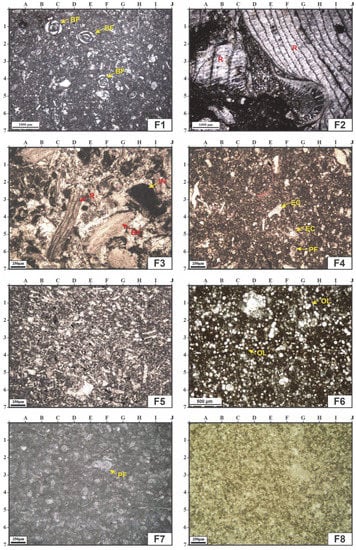
Figure 3.
Photomicrographs of depositional facies of the Sarvak Fm. in the studied fields from the Zagros Basin and the Persian Gulf. (F1): benthic foraminifera (BF) mudstone, wackestone; (F2): rudist (R)-algal-coral bafflestone, rudstone, floatstone; (F3): bioclast (bivalve: BV), peloid, intraclast (IN) packstone, grainstone; (F4): foraminifera (benthic and planktic: PF), bioclast (echinoid: EC) wackestone, packstone; (F5): microbioclast packstone, grainstone; (F6): oligosteginids (OL) wackestone, packstone; (F7): planktic foraminifera (PF) mudstone, wackestone; (F8): calcisiltite with sponge spicules. All photos in plane-polarized light.
- F1: Benthic Foraminifera Mudstone and Wackestone
This microfacies is marked by mud-supported textures in which benthic foraminifera such as miliolids, alveolinids, Nezzazata sp., and Dicyclina sp. are notable allochems (Figure 3). Peloids, oncoids, bivalves, and gastropods are subordinate constituents. It shows bioturbation as the only sedimentary feature. In the Abadan Plain and Dezful Embayment, green algae and calcareous sponge spicules are recorded within the facies.
- F2: Rudist-Algal-Coral Bafflestone, Rudstone, and Floatstone
This facies is dominantly composed of reef-builder biota including rudists, green algae, and corals (Figure 3). In almost all cases, in situ forms of these fossils are not recognized in subsurface areas of the Zagros Basin. Instead, they commonly occur as allochthonous reefal fragments with floatstone (mud-supported) to rudstone (grain-dominated) textures. Boring and burrowing are frequently recorded in this facies.
- F3: Bioclast, Peloid, Intraclast Packstone, and Grainstone
This microfacies encompasses all grain-dominated facies of the Sarvak Fm., with variable constituents including bioclasts (mostly rudists and echinoderms), peloids, and intraclasts (Figure 3). Cross-bedding is recognizable in the core samples of this facies.
- F4: Foraminifera (Benthic and Planktic), Bioclast (Echinoid) Wackestone, and Packstone
This facies shows a mixture of small benthic and planktic foraminifera along with echinoderms, bryozoan, red algae, bivalves, and intraclasts as the main allochems (Figure 3). A range of mud-supported (wackestone) to grain-dominated (packstone) textures is distinguished within this facies. Bioturbation is the only notable sedimentary feature of F4.
- F5: Microbioclast Packstone and Grainstone
This facies is marked by the dominance of fine to very fine sand-sized bioclasts indicating high levels of abrading. The bioclasts mostly include rudists and echinoderms (Figure 3). Pyrite and glauconite along with fine peloids are other notable constituents. This facies is dominantly recorded in the Fars area (Sarvestan and Saadat Abad fields) and the Persian Gulf (i.e., Sirri Field). Cross-bedding is a major sedimentary structure of F5.
- F6: Oligosteginids Wackestone and Packstone
The microfacies is mainly composed of oligosteginids that provide a range of grain-dominated to mud-supported textures (Figure 3). Planktic foraminifers, fine peloids, and rare echinoderm fragments are other allochems of this facies. Pyrite and glauconite are also present.
- F7: Planktic Foraminifera Mudstone and Wackestone
This facies contains various types of planktic foraminifera (Globigerinoides sp., Hedbergella sp., and Rotalipora sp.) in mud-dominated textures of mudstone to wackestone (Figure 3). Oligosteginids, fine peloids, and rare skeletal fragments (mostly echinoderms) are subordinate grains. Lamination and bioturbation are its important sedimentary features.
- F8: Calcisiltite with Sponge Spicules
This facies is characterized by the presence of silt-sized (highly abraded) skeletal debris (echinoderms, thin-shelled bivalves) and siliceous sponge spicules (Figure 3). Fine peloids, clacisphere (oligosteginids), and planktic foraminifera are subordinate constituents of this microfacies. Pyritization and glauconitic grains are also recorded. It shows lamination in some cases. This microfacies is mainly recorded from the Dezful Embayment.
4.2. Diagenesis
Various types of diagenetic alteration are recorded from the Sarvak carbonates throughout the Zagros Basin. They include isopachous (aragonite) cementation, micritization, bioturbation (boring and burrowing), dissolution (karstification), collapse brecciation, development of paleosol, silicification, recrystallization, equant and drusy calcite cementation, mechanical to chemical compaction (stylolitization), dolomitization, blocky calcite cementation, pyritization, and fracturing. Core photos and photomicrographs of the major diagenetic processes of the Sarvak Fm. are presented in Figure 4 and Figure 5. Brief descriptions of some major diagenetic alterations of this formation are presented below.
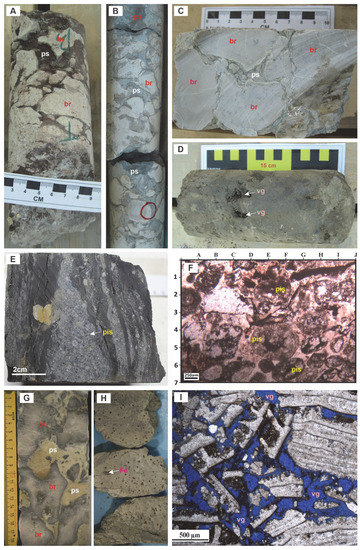
Figure 4.
Core photos and photomicrographs of major diagenetic features of the Sarvak Fm. in the Zagros Basin and the Persian Gulf. (A–C) Solution collapse breccia with paleosol (ps) filling spaces between breccia clasts (br); (D) vug/vuggy pores (vg); (E,F) pisolitic (pis) horizons; (G) solution collapse breccia with paleosol (ps) filling spaces between breccia clasts (br); (H) Fe concretions (Fe); (I) vug/vuggy pores (vg) in rudist-dominated facies.
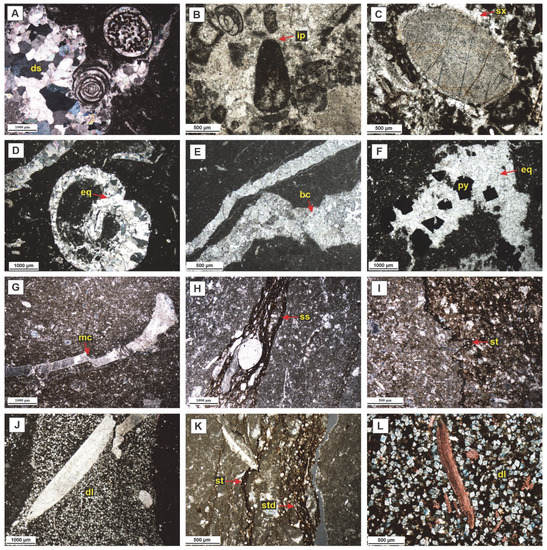
Figure 5.
Photomicrographs of diagenetic features of the Sarvak Fm. in the Zagros Basin and the Persian Gulf. Various types of cements are recorded, including drusy (A), isopachous (B), syntaxial (C), equant (D,F), and blocky (E) calcite cements. (G) Mechanical compaction; (H) solution seams; (I) stylolitization; (J–L) burial (stylolite-related) dolomitization. (A,D,H,I) are shown in cross-polarized light, others are shown in plane-polarized light. Abbreviations—ds: drusy, ip: isopachous, sx: syntaxial, eq: equant, bc: blocky, py: pyrite, mc: mechanical compaction, ss: solution seam, st: stylolite, dl: dolomitization, std: stylolite-related dolomitization. (L) is a stained thin section in which calcitic components are stained and dolomites remain unstained. Dolomites seem to be ferroan.
- Collapse Brecciation
Dissolution–collapse-brecciated units are common features in the topmost part of the Sarvak Fm., especially in the Dezful Embayment (Figure 4A–C) and Abadan Plain (Figure 4G,H). In these units, carbonate breccia clasts are consolidated together with paleosol infiltrated sediments (Figure 4A–C). The most typical brecciated intervals of the Sarvak Fm. are recorded from the Rag-e-Sefid, Gachsaran, and Azadegan fields (see Table 1).
- Dissolution (Karstification)
Dissolution molds, vugs, channels, and caves are frequently recorded from the Sarvak Fm. in the Zagros Basin (Figure 4D,I). On a microscopic scale, dissolution forms considerable amounts (up to 35%) of pores in the form of separate to touching vugs, especially within the grain-supported facies of F2 and F3 (see Table 2 and Figure 4). Parts of these dissolution vugs are subsequently filled by calcite cements; however, a major portion of them remains unfilled.
- Development of Paleosol
Iron- and aluminum-rich paleosols (bauxite and laterite) are common diagenetic features at the uppermost parts of the Sarvak Fm. in various parts of the Zagros Basin. They provide some economically important mineral deposits in the west and southwest of Iran (Hamedan, Kermanshah, Khuzestan, and Fars). In the subsurface, paleosols are recognized from the Gachsaran and Rag-e-Sefid oilfields in the Dezful Embayment (Figure 4A–C). In some localities, such as the Fars area and the Persian Gulf, pisolitic units are recorded at the top of the Sarvak Fm., beneath the disconformable surfaces (Figure 4E,F). They can be considered as stratigraphic equivalents of top-Sarvak paleosols in the neighboring areas. Paleosols show a close association with extensively dissolved and brecciated units of the Sarvak Fm. and, consequently, are known as the karst bauxite deposits in the Zagros Basin [40].
- Cementation
Various types of cements are recorded in the Sarvak Fm., including isopachous, equant, drusy, syntaxial, blocky, pendant, and bladed circumgranular calcite (Figure 5A–F). Isopachous, pendant, and syntaxial cements are frequently recorded within the grain-dominated facies (F3). Equant, drusy, and blocky calcites filled dissolution vugs and molds as well as fractures, especially within the karstified rudist-dominated facies (F2) of the Sarvak Formation (Figure 5A,B).
- Compaction
Effects of mechanical and chemical compaction are frequently recorded in the Sarvak Fm. in the form of deformed and broken grains and the development of solution seams and stylolites (Figure 5G–I). The latter features are among the most frequent and important diagenetic features of the Sarvak Fm. in the Zagros Basin. Solution seams are commonly recorded within the mud-dominated facies of F1 and F7 (Table 2). In contrast, stylolites are predominantly observed in the grain-supported facies, including F2 to F5 (see Figure 5I and Table 2).
- Dolomitization
Dolomites of the Sarvak Fm. are mainly concentrated along the solution seams and stylolites (Figure 5J–L). They are made up of euhedral to subhedral crystals with a size ranging from silt to very fine sand (up to 8 μm). In some cases, they show a cloudy center surrounded by a clear margin. In stained thin sections, dolomites seem to be ferroan (Figure 5L). Dolomitization predominantly occurred within the mud-dominated facies (mud- to wackestone) of open marine and lagoonal settings. These replacement dolomites are commonly concentrated along the chemical compaction features (i.e., solution seams and stylolites) and their frequency ranges from >5% up to 65%. Dolomitization was mostly fabric-selective and fabric-retentive (Figure 5J–L). It is frequently recorded from the Sarvak Fm. in the Dezful Embayment and Abadan Plain. It is also recorded as a minor diagenetic feature in the Persian Gulf oilfields. Saddle/baroque dolomites are also present, with a very low frequency, in the mentioned areas [1]. It is commonly recorded as fracture-filling cement.
4.3. Bio- and Sequence Stratigraphy
Cenomanian–Santonian sedimentary sequences in the Zagros Basin are marked by three well-known biozones defined based on the benthic foraminiferal assemblages within the shallow-marine carbonates of the Sarvak and Ilam formations (see [11] for more details). They include the following:
- Biozone 1: Nezzazata–Alveolinids assemblage zone; biozone #25 of [41], (Cenomanian);
- Biozone 2: Nezzazatinella–Dicyclina interval zone; biozone #29 of [41], (Turonian);
- Biozone 3: Rotalia sp.22–algae assemblage zone; biozone #30 of [41], (Santonian).
Each of these biozones correspond to a third-order depositional sequence of Cenomanian (Sv_Cen), Turonian (Sv_Tur), and Santonian (IL_San) ages (Figure 6). Depositional sequences of the Sarvak Fm. are easily differentiable based on the presence of two regional disconformable surfaces at the Cenomanian–Turonian boundary (known as CT-ES) and middle Turonian (mT-ES). These paleoexposure surfaces are considered as type-I (erosional) sequence boundaries at the top of the Sv_Cen and Sv_Tur sequences (Figure 6).
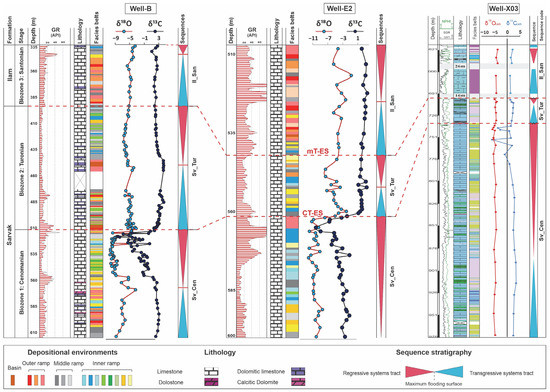
Figure 6.
Chemo-sequence stratigraphic correlation of the Sarvak and Ilam formations across the studied wells. Three third-order sequences are shown that are dated according to the results of biostratigraphic studies. They include Cenomanian (Sv_Cen), Turonian (Sv_Tur), and Santonian (IL_San) sequences.
Within these third-order sequences, the vertical accumulation of outer ramp, basin, and middle ramp facies formed the transgressive systems tracts (TSTs), and inner ramp facies (lagoon, shoal, and reef talus) formed the regressive systems tracts (RSTs). The deepest marine facies (F7 and F8) are considered as the maximum flooding surfaces (MFSs) (Figure 6).
4.4. Geochemistry
4.4.1. Trace Elements
The elemental (Ca, Mg, Sr, Fe, Al, Mn, and Rb) analysis indicates some remarkable and meaningful variations in the Sarvak Fm. (Figure 7). Here, the results of the elemental analysis of Abteymour Well-A are presented as the key well, but evidence from other studied sections will be provided in the following sections.
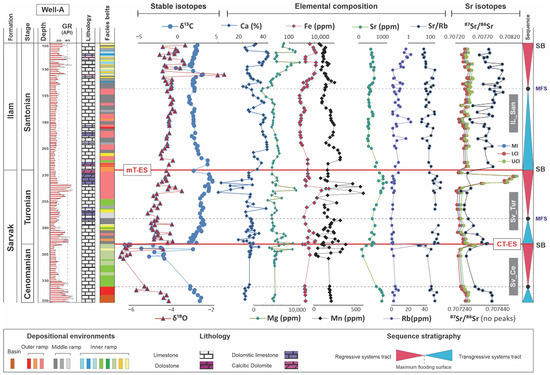
Figure 7.
Integrated geochemical log of the Sarvak and Ilam formations in Abteymour Oilfield (Well-A). Elemental, carbon and oxygen, and 87Sr/86Sr ratios are shown along with the sedimentological characteristics (facies and sequences) of these formations. Paleoexposure surfaces are marked as CT-ES (Cenomanian–Turonian boundary exposure surface) and mT-ES (middle Turonian exposure surface).
Among the tested elements, Mg and Fe show a strong covariance across the studied intervals. The Mg content ranges from 1700 to 37,410 ppm (average: 5173 ppm) with maximum concentrations below the mT-ES (Figure 7) and within the Ilam Fm. (37,410 ppm). The Fe values are measured as 500 to 42,000 ppm (average: 2040 ppm) with similar trends of variations to Mg. The maximum Fe concentration is measured from the altered carbonates beneath the mT-ES. In contrast, no major changes are distinguished below the CT-ES (Figure 7).
The manganese (Mn) content of the analyzed samples shows remarkable fluctuations from 25 to 605 ppm (average: 188 ppm). The perturbations in Mn concentration are mainly recorded at two stratigraphic intervals around the CT-ES and mT-ES (Figure 7). However, all of the peaks of Mn are not related to the paleoexposures. Some Mn variations are also recorded within the Ilam Fm. (i.e., IL_San sequence).
The strontium (Sr) concentrations range from 150 ppm to 1250 ppm (average: 649 ppm) in the studied sequences (Figure 7). The lowest Sr content is measured from the altered carbonates below the CT-ES (i.e., Sv_Cen sequence). In the Sv_Tur sequence, the Sr content shows an upward increasing trend that reaches the maximum value of 1250 ppm beneath the mT-ES (Figure 7). Two different trends are visible in the Sr content of the Ilam Fm. (IL_San sequence), which include an upward decreasing trend within the TST that is followed by an increase in Sr content within the RST.
The rubidium (Rb) concentration of the studied samples varies between 0 and 42 ppm, with an average of 8 ppm. A sharp increase in Rb content is visible just below the CT-ES, while there is no detectable change around the mT-ES. The maximum variations in Rb are measured from the Ilam carbonates with a general increasing trend (range: 2–24 ppm, average: 9.5 ppm) (Figure 7).
Cross plots of Mn vs. δ18Ocarb and Mn vs. Sr/Ca are presented in Figure 8 for the Sarvak and Ilam formations in the Ahwaz Well-B and Rag-e-Sefid Well-D. The expected ranges for the Cretaceous marine carbonates are shown on the Mn vs. δ18Ocarb plot (Figure 8B,D). Deviations from the expected ranges are clearly visible for the Cenomanian and Turonian sequences of the Sarvak Fm. (Figure 8). These samples are marked by their decreased δ18Ocarb values (−4‰ to −7‰) and increased Mn contents (100 to 550 ppm).
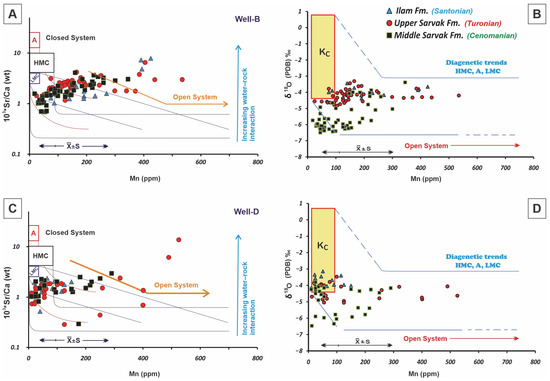
Figure 8.
Cross plots of Mn vs. Sr/Ca (A,C) and Mn vs. δ18Ocarb (B,D) for analyzed samples from the Sarvak and Ilam formations in the Ahwaz (Well-B: plots (A,B)) and Rag-e-Sefid (Well-D: plots (C,D)) fields in the Dezful Embayment. A: aragonite; HMC: high-magnesium calcite; LMC: low-magnesium calcite; KC: expected range for Cretaceous marine calcite [42]. X-bar: mean, S: standard deviation.
Plots of Mn vs. Sr/Ca indicate remarkable deviations of analyzed samples compared to the expected ranges of the aragonite (indicated by A in Figure 8A,C), high-magnesium calcite (HMC), and low-magnesium calcite (LMC) (Figure 8A,C). They are marked by increased Mn contents. The Sr/Ca values of analyzed samples are all in the ranges of expected values for the HMC and LMC (Figure 8A,C).
4.4.2. Carbon and Oxygen Isotopes
The δ13Ccarb and δ18Ocarb values are measured from Cenomanian–Santonian sequences in various parts of the Zagros Basin (Figure 7 and Figure 9). The δ13Ccarb values vary between 4‰ and −8‰ in the studied wells. The lowest values of δ13Ccarb are measured from the upper parts of the Cenomanian (Sv_Cen) and Turonian (Sv_Tur) sequences in the Sarvak Fm. (Figure 9).
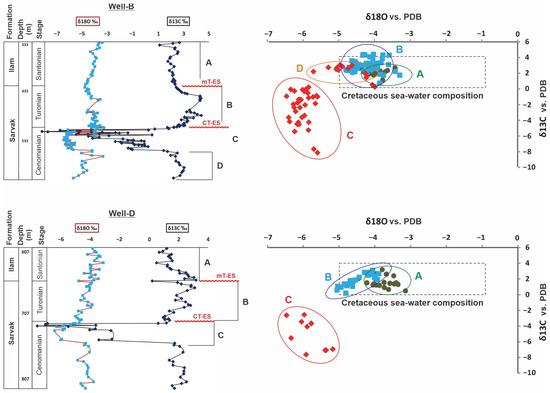
Figure 9.
Plots of carbon and oxygen isotopic rations versus depth and their cross plots in the Ahwaz (Well-B) and Rag-e-Sefid (Well-D) fields. According to their stratigraphic positions, the samples were categorized into four classes of A to D. Paleoexposure surfaces are marked as CT-ES (Cenomanian–Turonian boundary exposure surface) and mT-ES (middle Turonian exposure surface).
In the Cenomanian sequence, the positive δ13Ccarb values (2‰ to 3‰) change upwards to the negative values of −6‰ to −8‰. A similar upward decreasing trend is also visible in the Turonian sequence, where δ13Ccarb values of 3‰ to 4‰ decrease upward to 0‰ to 1‰ (Figure 9). In the Ilam Fm. (IL_San), a narrow variation in δ13Ccarb is measured between 2‰ and 3‰ (Figure 7).
The δ18Ocarb values of the analyzed samples range from −1‰ to −7‰ in the studied sections (Figure 9). Similar to δ13Ccarb, the minimum values of δ18Ocarb are recorded from the samples taken from the uppermost parts of Sv_Cen sequence of the Sarvak Fm. (Figure 7 and Figure 9). In the RST of this sequence, the δ18Ocarb values vary between −5‰ and −7‰ (Figure 7). A sharp decrease in δ18Ocarb values is not measured from the Sv_Tur and IL_San sequences. However, a small decrease in δ18Ocarb is noted just below the mT-ES in the Ahwaz (Well-B) and Rag-e-Sefid (Well-D) sections (Figure 9). The δ18Ocarb values of the Ilam Fm. show similar values around −4‰.
Cross plots of δ13Ccarb vs. δ18Ocarb are shown for the studied sequences in wells B and D in Figure 9. In these plots, analyzed samples are categorized into four classes marked as A to D.
Class A includes samples of the Ilam Fm. (IL_San sequence) that fall within the expected ranges of the Cretaceous marine carbonates. In this class, δ18Ocarb values range from −3‰ to −4‰, and δ13Ccarb varies between 0‰ and 4‰ (Figure 9).
Class B encompasses the samples of the Turonian sequence (Sv_Tur) with δ13Ccarb values similar to the expected ranges of Cretaceous marine carbonates (0‰ to 4‰) and decreased values of δ18Ocarb (−4‰ to −5.5‰) (Figure 9).
Class C incorporates the samples that belong to the RST of the Cenomanian sequence (Sv_Cen) with very low values of δ13Ccarb (0‰ to −9‰) and δ18Ocarb (−5‰ to −7‰). Samples of this class plotted far from the expected isotopic ranges for the Cretaceous marine carbonates (Figure 9).
Class D includes those samples taken from the TST of the Cenomanian sequence (Sv_Cen). The δ13Ccarb values of these samples are in the expected range of Cretaceous marine carbonates (0‰ to 4‰). A 1‰ decrease is recorded in the δ18Ocarb values of this class (Figure 9).
4.4.3. Strontium Isotopes
The 87Sr/86Sr ratios of carbonate samples from the Sarvak and Ilam formations are plotted in stratigraphic order in Figure 10, along with the defined biozones for relative dating of the studied intervals. As shown, there are two remarkable increases in the 87Sr/86Sr ratios of the analyzed samples at the two paleoexposure surfaces (i.e., CT-ES and mT-ES) at the top of the Sv_Cen and Sv_Tur sequences (Figure 10). In the Abteymour Field (Well-A), the highest values of 87Sr/86Sr are recorded just below the CT-ES (0.707534 ± 24 × 10−6) and mT-ES (0.708259 ± 38 × 10−6). Accordingly, clear increases in 87Sr/86Sr ratios are recorded in the topmost parts of the Cenomanian and Turonian sequences (Figure 10). The 87Sr/86Sr ratios of the Ilam Fm. show a narrow range with a relatively uniform distribution across the studied wells (Figure 10). In Well-A, the 87Sr/86Sr ratios of this formation range from 0.707282 ± 30 × 10−6 to 0.707393 ± 28 × 10−6 (Figure 10).
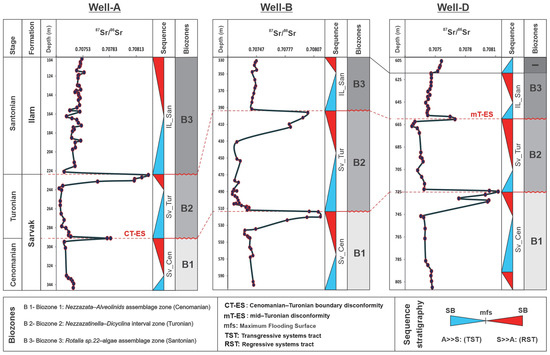
Figure 10.
Strontium isotope stratigraphic (SIS) correlation of the Sarvak and Ilam formations across the Abteymour (Well-A), Ahwaz (Well-B), and Rag-e-Sefid (Well-D) fields in the Dezful Embayment. Sharp increases in 87Sr/86Sr ratios are measured around the paleoexposure surfaces. Third-order sequences and biozones are also shown.
For the absolute dating of the studied sequences, the 87Sr/86Sr ratios of the analyzed samples were plotted on the standard 87Sr/86Sr curves of Mc Arthur [37] for the Albian–Campanian time span (Figure 11). A rubidium correction was applied to the analyzed samples, and diagenetically altered samples were removed from the database. Then, the 87Sr/86Sr ratios of the remaining (unaltered) samples were plotted on the standard diagram. Lower and upper age limits along with mean age values were considered for each sample. Stratigraphic hiatuses were determined, and their associated time gaps were calculated (see [16] for full methodology). Accordingly, the duration of the paleoexposure event at the CT-ES was calculated as 0.53 Myr for Well-A and 0.39 Myr for Well-D. Comparatively longer time gaps were estimated for the mT-ES as 2.7 Myr in Well-A and 4.5 Myr in Well-D (Figure 11).
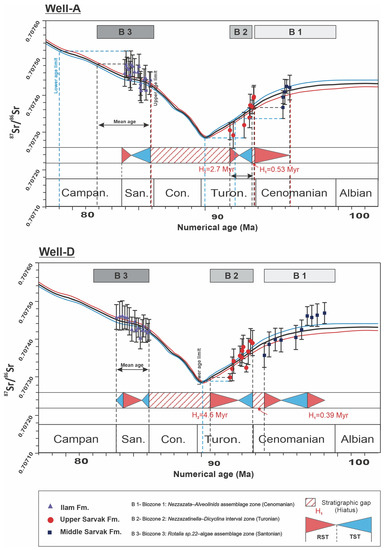
Figure 11.
Plots of 87Sr/86Sr ratios of selected samples for absolute dating of the Sarvak and Ilam formations on the standard curve of Albian–Campanian [37]. Diagrams are plotted for the Abteymour (Well-A) and Rag-e-Sefid (Well-D) fields. Third-order sequences and biozones are also shown along with the calculated hiatus durations at the Cenomanian–Turonian (CT-ES) and middle Turonian (mT-ES) paleoexposure surfaces.
5. Discussion
5.1. Depositional Model
The results of the microfacies analysis of the Sarvak Fm. in 13 hydrocarbon fields show that it is mainly composed of eight facies types (see Table 2 and Section 4.1). Facies characteristics and their correlation with standard models (e.g., [36]) and previous studies indicated that they can be classified into four main facies associations, including inner ramp, middle ramp, outer ramp, and basin. Furthermore, inner ramp facies can be subdivided into three categories as lagoon (F1: benthic foraminifera mudstone, wackestone), patch reef taluses (F2: rudist-algal-coral bafflestone, rudstone, floatstone), and shoal (F3: bioclast, peloid, intraclast packstone, grainstone). Middle ramp facies include mud- to grain-supported facies with dual textural characteristics and fossil content.
In these facies, a mixture of neritic and pelagic biota was recorded (F4: foraminifera, bioclast wackestone, packstone). Extremely abraded and cross-bedded grain-dominated facies that are mainly composed of echinoderm debris and planktic foraminifers (F5: microbioclast packstone, grainstone) are attributed to the distal mid-ramp setting, around the storm wave base (SWB), as tempestites. Mud-dominated facies containing oligosteginids (F6) and planktic foraminifers (F7) are interpreted as outer ramp facies. Basinal facies include calcisiltite with frequent siliceous sponge spicules (F8).
Accordingly, the absence of continuous reefs and evidence of remarkable differences in depositional depth (e.g., reworked sediments, debris flows, or turbidites) all indicate that the Sarvak Fm. was deposited in a ramp-like carbonate platform in most parts of the Zagros Basin and the Persian Gulf. A similar model was also proposed previously for this formation in the other parts of the Zagros Basin, such as the Izeh Zone [43,44] and the Lorestan Zone [45]. In some localities (e.g., Lorestan and southern parts of the Dezful Embayment), the development of intra-platform basins and seaways provided a general open (non-rimmed) shelf configuration. Recently, Moeini et al. [46] proposed an isolated platform model for the Cenomanian sequences in the Lorestan Zone.
The conceptual depositional model, frequencies of facies associations, and paleogeographic setting of the Sarvak Fm. are presented in Figure 12. As shown, during the Cenomanian–Turonian, the shallow-marine carbonate platforms were developed on the northeastern margin of the Arabian Plate [3,28,29]. These platforms were dominantly ramp-like and surrounded some intra-platform basins in various parts of the Middle East [5,10,22,27]. Rudist bioherms (patch reefs) developed in the shallow (inner) parts of these ramps and provide important reservoir units in the Sarvak Fm. in Iran [21,47] and its stratigraphically equivalent strata in Iraq [48,49], UAE [50], Qatar [51], and Oman [52,53].
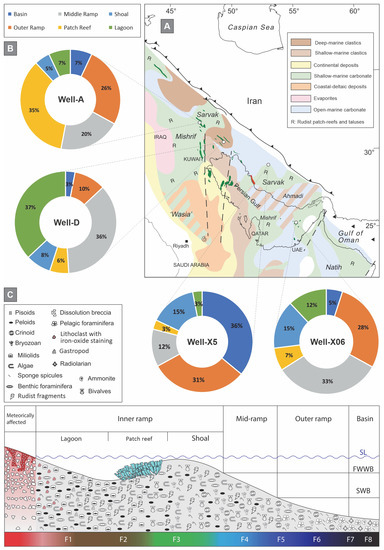
Figure 12.
(A) Paleogeographic map of the Zagros Basin and Persian Gulf during the Cenomanian (modified after [28]). (B) Frequency diagrams of facies associations of the Sarvak Fm. in the Abteymour (Well-A), Rag-e-Sefid (Well-D), Sarvestan (Well-X5), and Sirri (Well-X06) fields. (C) Conceptual depositional model of the Sarvak Fm. in the Zagros Basin and the Persian Gulf.
The results of the frequency analysis show that there are remarkable differences in the frequency of facies associations among the studied fields from different parts of the Zagros Basin (Figure 12B). Accordingly, nearly 50% of the Sarvak Fm. is composed of inner ramp (lagoon, shoal, and patch reef) facies in the Dezful Embayment. In contrast, deep-marine (outer ramp and basin) facies formed 67% of this formation in the Fars Zone (i.e., Sarvestan Field, Well-X5; Figure 12B). In the eastern Persian Gulf, shallow-marine (inner ramp) facies become dominant, with a frequency of 55% (Figure 12B). Similar drastic changes in the frequency of facies associations and thickness of the Sarvak Fm. were previously reported from the Zagros Basin and the Persian Gulf (see [7]). They can be attributed to the effects of tectonic activities that were related to the onset of Neo-Tethys subduction beneath Central Iran and its consequent compressional regime, which reactivated the basement faults and salt diapirs [54,55,56].
5.2. Diagenetic History
A schematic diagenetic model and paragenetic sequence of the Sarvak Fm. are presented in Figure 13 and Figure 14, respectively. The diagenetic model is specifically provided for rudist-dominated facies of this formation in the studied fields (Figure 13). The paragenetic sequence of diagenetic processes includes marine, meteoric, and shallow- to deep-burial diagenesis (Figure 14).
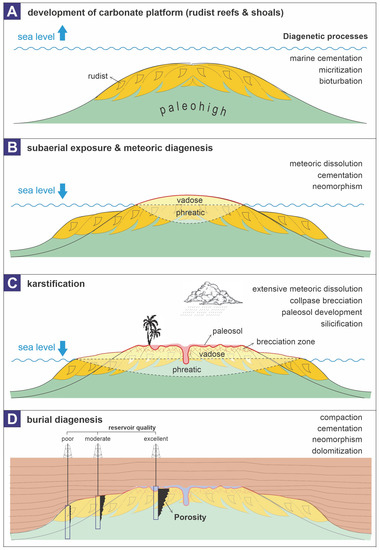
Figure 13.
Schematic cartoons illustrating the diagenetic history of the Sarvak Fm. in the Zagros Basin and the Persian Gulf (modified after [47]). This model includes marine (A), meteoric (B,C), and burial (D) diagenetic realms and their associated diagenetic processes.

Figure 14.
Paragenetic sequence of diagenetic features recorded in the Sarvak Formation.
The diagenetic history of the Sarvak Fm. is highly variable across the Zagros Basin and the Persian Gulf. Depending on the paleo-structural altitude, one, two, and sometimes three disconformable surfaces were formed following the subaerial exposure of carbonates in the mid-Cenomanian (mC-ES), Cenomanian–Turonian boundary (CT-ES), and middle Turonian (mT-ES) [1,57,58]. Consequently, meteoric diagenesis was the most important phase in the diagenetic evolution of the Sarvak Fm. [14,59,60].
Meteoric diagenetic features, including dissolution (karstification), brecciation, cementation, and paleosol formation, had remarkable control over the reservoir properties of this formation throughout the Zagros and Persian Gulf [21,58,61,62].
The number and intensity of meteoric phases were directly controlled by tectonics. On paleohighs (uplifted blocks), three paleoexposure events occurred along with karstified intervals with variable maturities. For example, in the Gachsaran and Rag-e-Sefid fields, the maximum development of karstified profiles is observed. In these fields, thick paleosol units and brecciated intervals point to an over-matured karst profile, especially beneath the mT-ES. In these localities, the diagenetic history of the Sarvak Fm. includes two phases of meteoric diagenesis: (a) eogenetic meteoric diagenesis at the time of exposure and (b) telogenetic meteoric diagenesis in the Cenomanian sequence at the mid-Turonian exposure event [1].
Similar phenomena were also recorded in the Hendijan and Bahregansar fields (NW Persian Gulf). However, in the Fars Zone (Sarvestan, Saadat Abad) and eastern Persian Gulf (Sirri Field), immature (young) karsts occur below the disconformable surfaces, which are associated with preserved dissolution features such as vugs, caves, and channels, especially beneath the CT-ES. Moreover, minor effects of marine diagenesis and intensive burial diagenetic features are distinguished within the Sarvak Fm. (Figure 14). Isopachous cementation, micritization, and bioturbation are marine diagenetic processes.
Burial diagenetic processes include blocky calcite cementation, mechanical and chemical compaction, stylolite-related dolomitization, pyritization, and fracturing. The mineral stabilization and cementation of meteorically affected carbonates have resulted in lesser effects of burial diagenesis on karstified intervals of the Sarvak Fm. Our previous studies proved that the dolomitized units of the Sarvak Fm. provide some productive (reservoir) zones of this formation in the Dezful Embayment, Abadan Plain, and the Persian Gulf [8,9,20]. This diagenetic process improved the reservoir quality of the Sarvak Fm. by increasing the permeability. The possible sources of Mg are assumed to be the dissolution of skeletal grains with high-Mg calcite (HMC) mineralogy and Mg2+ released during the transformation of clay minerals [20].
The diagenetic history of the Sarvak Fm. is the subject of several studies in south and southwest Iran [14,15,58,61,63] and other places in the Middle East [64]. In all of these studies, relatively similar diagenetic models are discussed, and meteoric diagenesis has been considered as the main phase of diagenesis in Cenomanian–Turonian carbonate rocks.
Paleoexposure-related diagenetic processes were the main controlling factors on reservoir properties of the Sarvak Fm. Extensive dissolution (karstification) formed high amounts (up to 35%) of vuggy, moldic, channel, and enlarged fracture pores within the neritic facies of this formation. The high-energy shoal and rudist-dominated facies of reef talus environments were potentially high-quality reservoir facies. They contain high amounts of primary pores such as interparticle, intraskeletal, and growth framework pores (Figure 14). This primary good reservoir potential was multiplied through meteoric dissolution.
Considering their control over reservoir properties, the diagenetic processes of the Sarvak Fm. can be classified into three main classes: (a) diagenetic processes with positive effects on reservoir quality, including dissolution, dolomitization, and fracturing; (b) diagenetic processes with negative effects on reservoir properties, such as compaction, brecciation, and cementation; and (c) diagenetic processes with minor effects on reservoir quality, including micritization, recrystallization, bioturbation, silicification, and pyritization.
5.3. Geochemistry
The complex depositional–diagenetic evolution of the Sarvak Fm. has resulted in remarkable changes in elemental and isotopic compositions and conspicuous geochemical trends within this formation across the study area (see Section 4.4). Most of these geochemical trends are related to the paleoexposure surfaces and their associated meteoric diagenetic alteration. Therefore, they provide very useful tools for delineating the disconformities that are considered as important sequence boundaries for the sequence stratigraphic analysis of the Sarvak Fm.
5.3.1. Trace Elements
Beneath the paleoexposure surfaces, an increase in Mg, Fe, and Rb concentrations and a decrease in Sr content all point to a major phase of meteoric diagenesis. Such variations in elemental concentrations are observed in the karstified intervals below the CT-ES and mT-ES (Figure 7). The amplitude of elemental changes is higher below the mT-ES (Figure 7). The meteoric waters contain lower Sr and higher Mn and Fe concentrations compared to the marine carbonates [42]. As a result, it is routinely expected that meteorically altered carbonates show a decrease in Sr and an increase in Mn and Fe contents [42]. The subaerial exposure of carbonates usually increases the aluminosilicate detritus input (i.e., clay minerals) and, consequently, increases the Rb content of altered carbonates [37,65,66]. Afterwards, this Rb content can alter the 87Sr/86Sr signature of the host rocks due to in situ decay [16,18,19,38,66,67]. Therefore, the lowest Sr/Rb ratios are measured from the weathered intervals below the paleoexposure surfaces.
The cross plots of Sr/Ca vs. Mn and δ18Ocarb vs. Mn also indicate an extensive effect of meteoric waters on the carbonates of the Sarvak Fm. in an open diagenetic system (Figure 8). The decrease in the Sr/Ca ratios and δ18Ocarb along with the increase in the Mn concentration of the analyzed samples all point to a major meteoric diagenesis under the high water-to-rock ratio condition [42]. These samples are not suitable for absolute age calculation using the 87Sr/86Sr ratios. Samples taken far from the paleoexposure surfaces show lesser effects of meteoric diagenesis, which are reflected in their higher Sr/Ca ratios and δ18Ocarb values and lower Mn concentrations. These samples belong to the transgressive system tracts of the Sv_Tur and Sv_Cen sequences of the Sarvak Fm. and the total interval of the Ilam Fm. (IL_San sequence).
5.3.2. Carbon and Oxygen Isotopes
The δ13Ccarb and δ18Ocarb values provide useful tools for evaluating the diagenetic impact on carbonate rocks of the Sarvak Fm. Decreased values of δ13Ccarb and δ18Ocarb are recorded from the RSTs of the Cenomanian and Turonian sequences, below the CT-ES and mT-ES (see Figure 9). Such low values point to a severe meteoric diagenesis, including the dissolution of calcium carbonate and its reprecipitation in the form of LMC (low-magnesium calcite) cements containing 13C and 18O-depleted CO3 [68,69,70]. The sharp inverted-J patterns on the δ13Ccarb vs. δ18Ocarb cross plots provide another strong clue for the meteoric diagenesis effect on carbonates of the Sarvak Fm. [71,72]. The samples with decreased values of δ13Ccarb and δ18Ocarb stratigraphically belong to the uppermost parts (RSTs) of the Cenomanian (Sv_Cen) and Turonian (Sv_Tur) sequences of the Sarvak Fm. (Figure 7 and Figure 9). These meteorically altered samples mostly include drusy calcite cements and recrystallized micrite along with samples taken from paleosols and brecciated intervals, which were not appropriate for absolute dating using their 87Sr/86Sr ratios (Figure 15). Relatively uniform values of both δ13Ccarb and δ18Ocarb in the Ilam Fm. indicate lesser diagenetic effects on the carbonates of this formation. Similar geochemical trends were also reported from the Sarvak and Ilam formation by other researchers from various parts of the Zagros Basin in Iran [13,14,15,30,43] and other places in the Middle East [3,48].
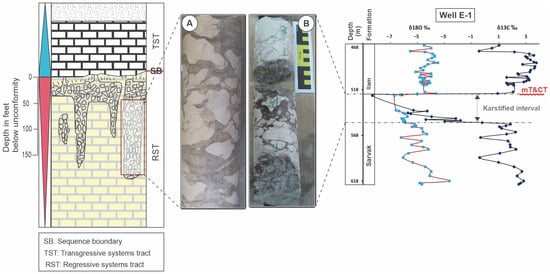
Figure 15.
Stable isotopic signature of karstified and brecciated intervals of the Sarvak Fm. in the Gachsaran Field (Well-E1). As shown, a pronounced decrease in the δ13Ccarb and δ18Ocarb values provides a useful tool for delineating the paleoexposure surfaces and karstified units.
5.3.3. 87Sr/86Sr Ratios
The 87Sr/86Sr ratios of carbonates are used for (a) delineating the precise stratigraphic position of disconformable (paleoexposure) surfaces, (b) the absolute dating of studied sequences, (c) calculating the length of the time gap (hiatus duration) along the paleoexposures, and (d) the chemostratigraphic correlation and sequence stratigraphic analysis of Cenomanian–Santonian rocks throughout the Zagros Basin and the Persian Gulf.
An increase in the 87Sr/86Sr ratios may also be caused by the admixture of isotopically heavy strontium derived from the weathering of continental deposits [66]. A sharp increase in the 87Sr/86Sr ratios of carbonates just below the disconformities makes it easy to delineate the precise stratigraphic positions of CT-ES and mT-ES in the Sarvak Fm. (Figure 10). As mentioned, the in situ decay of Rb was responsible for the increase in the 87Sr/86Sr ratios of meteorically altered carbonates [66,67]. In all of the studied wells, such sharp spikes in the 87Sr/86Sr logs of the studied sequences are visible, which provided useful tools for stratigraphic correlation.
Absolute dating of the studied sequences revealed that the exposure duration at the CT-ES was generally lower than 1 Myr. This short-term exposure resulted in the development of dissolution features such as vugs and channels (immature/young karst) in the Cenomanian sequence (Sv_Cen) of the Sarvak Fm. This karstified interval, which commonly formed within the rudist-dominated facies of the Sarvak Fm., provides the best reservoir unit (productive zone) of this formation throughout the Zagros Basin [8,9,20,58]. On the other hand, the exposure duration was calculated as 2–7 Myr for mT-ES, which is much longer than the CT-ES. Such prolonged subaerial exposure of carbonates under the warm and humid (tropical) paleoclimatic conditions of the Arabian Plate during the Late Cretaceous resulted in the formation of an over-matured (senile) karst profile. Karst over-maturation is marked by the collapse and brecciation of dissolved carbonates and the development of paleosols [73]. Such over-matured karst profiles are typically recorded in oilfields located on the structural paleohighs such as the Hendijan, Bahregansar, Gachsaran, and Rag-e-Sefid fields in the Dezful Embayment and NW Persian Gulf. In the Fars Zone and eastern Persian Gulf, salt tectonics had the main control over the development and diagenetic evolution of Late Cretaceous platforms.
6. Conclusions
The integrated sedimentological and geochemical analysis of the Sarvak Fm. and lower parts of the Ilam Fm. in 13 subsurface sections from various parts of the Zagros Basin and the Persian Gulf has resulted in the following conclusions:
- Microfacies analysis and palaeoenvironmental reconstruction indicate that the Sarvak Fm. is composed of eight facies types representing a general ramp-like depositional model. Rudists were the main carbonate producers in this platform. Tectonic and eustatic factors were responsible for highly variable depositional settings. Accordingly, the large variations in spatial facies distribution and thickness of this formation were associated across the studied sections. Close to the intra-platform basins, the general depositional model can be considered as an open (non-rimmed) shelf, where abrupt changes from inner to outer platform facies are associated with frequent debrites and tempestites (e.g., in the Fars Zone, close to the platform edge).
- Paleo-structural features such as the paleohighs, troughs, intra-platform basins, and seaways had major control over facies characteristics and the diagenetic evolution of the Sarvak Fm. The maximum development of shallow-marine facies (lagoon, patch reefs, and shoals) is visible in some areas of the Dezful Embayment (e.g., Gachsaran and Rag-e-Sefid fields) and the NW Persian Gulf (Hendijan and Bahregansar fields). In these localities, well-known paleohighs were formed by the reactivated basement faults, during and after the deposition of the Sarvak Fm. Far from these paleohighs, the depositional–diagenetic evolution of this formation was completely different.
- Diagenesis had a major impact on the carbonates of the Sarvak Fm. Among the marine, meteoric, and shallow- to deep-burial diagenetic realms, the main diagenetic phases occurred at the end of the Cenomanian and Turonian in rocks of this formation. Consequently, two karstified intervals are commonly distinguishable in the Sarvak Fm. within the RSTs of the Cenomanian and Turonian third-order sequences. Intensive meteoric dissolution, cementation, brecciation, silicification, and development of paleosols are major paleoexposure-related diagenetic alterations in this formation. The frequency, type, and intensity of these alterations are remarkably different throughout the Zagros Basin and the Persian Gulf.
- Conspicuous geochemical trends are observed in the studied sections, which were related to the disconformities. An increase in Mg, Fe, Mn, and Rb and a decrease in Ca and Sr together with decreased δ13Ccarb and δ18Ocarb values and sharp increases in the 87Sr/86Sr ratios are recorded from the meteorically altered intervals below the paleoexposure surfaces. Sr-isotope dating of the Sarvak Fm. provides a reliable chemostratigraphic framework for this formation across the study area.
- Short-term subaerial exposures are calculated for the CT-ES with a duration of <1 Myr. In contrast, exposure duration was much higher for the mT-ES (2 to 7 Myr). Such remarkable differences in exposure durations have resulted in two different scenarios of karst formation and evolution below these disconformities. A short-term subaerial exposure is inferred for the Cenomanian–Turonian boundary event (CT-ES), which resulted in the development of dissolution features such as vugs and channels and their preservation (i.e., immature stage of karst). Below this disconformity, the reservoir properties of the Sarvak Fm. were improved, and the best productive zones of this formation were formed within the dissolved rudist-dominated facies. However, long-term exposure at mT-ES resulted in the collapse and brecciation of the karstified strata (senile stage) and, consequently, lower reservoir quality. Such differences are also reflected by geochemical trends and had major control over the reservoir properties of the Sarvak Fm. in its different depositional sequences.
- There is a close correspondence between the development (spatial and temporal) of rudistid facies, the intensity of karstification, and, finally, the reservoir quality of the Sarvak Fm. Consequently, thicker rudistid zones commonly show higher degrees of meteoric dissolution (diagenesis) and better reservoir quality. The interplay between the depositional facies characteristics and diagenetic alteration resulted in the development of the second most important hydrocarbon reservoir in Iran (i.e., the Sarvak Fm.) in the Zagros Basin and the Persian Gulf.
Funding
This research received no external funding.
Data Availability Statement
Data will be available on request.
Acknowledgments
The University of Tehran provided the facilities for this research, for which the author is grateful. The National Iranian Oil Company is thanked for data support.
Conflicts of Interest
The author declares no conflict of interest.
References
- Rahimpour-Bonab, H.; Mehrabi, H.; Enayati-Bidgoli, A.H.; Omidvar, M. Coupled imprints of tropical climate and recurring emergence on reservoir evolution of a mid-Cretaceous carbonate ramp, Zagros Basin, southwest Iran. Cretac. Res. 2012, 37, 15–34. [Google Scholar]
- Rahimpour-Bonab, H.; Mehrabi, H.; Navidtalab, A.; Omidvar, M.; Enayati-Bidgoli, A.H.; Sonei, R.; Sajjadi, F.; Amiri-Bakhtyar, H.; Arzani, N.; Izadi-Mazidi, E. Palaeo-exposure surfaces in Cenomanian-Santonian carbonate reservoirs in the Dezful Embayment, SW Iran. J. Pet. Geol. 2013, 36, 335–362. [Google Scholar] [CrossRef]
- Bromhead, A.D.; van Buchem, F.S.P.; Simmons, M.D.; Davies, R.B. Sequence stratigraphy, palaeogeography and petroleum plays of the Cenomanian–Turonian succession of the Arabian Plate: An updated synthesis. J. Pet. Geol. 2022, 45, 119–161. [Google Scholar] [CrossRef]
- Ghabeishavi, A.; Vaziri-Moghaddam, H.; Taheri, A.; Taati, F. Microfacies and depositional environment of the Cenomanian of the Bangestan anticline, SW Iran. J. Asian Earth Sci. 2010, 37, 275–285. [Google Scholar] [CrossRef]
- Mehrabi, H.; Rahimpour-Bonab, H. Paleoclimate and tectonic controls on the depositional and diagenetic history of the Cenomanian-early Turonian carbonate reservoirs, Dezful Embayment, SW Iran. Facies 2014, 60, 147–167. [Google Scholar] [CrossRef]
- Mehrabi, H.; Rahimpour-Bonab, H.; Enayati-Bidgoli, A.H.; Navidtalab, A. Depositional environment and sequence stratigraphy of the Upper Cretaceous Ilam Formation in central and southern parts of the Dezful Embayment, SW Iran. Carbonates Evaporites 2014, 29, 263–278. [Google Scholar] [CrossRef]
- Mehrabi, H.; Rahimpour-Bonab, H.; Hajikazemi, E.; Jamalian, A. Controls on depositional facies in upper cretaceous carbonate reservoirs in the Zagros area and the Persian Gulf, Iran. Facies 2015, 61, 23. [Google Scholar] [CrossRef]
- Mehrabi, H.; Rahimpour-Bonab, H.; Enayati-Bidgoli, A.H.; Esrafili-Dizaji, B. Impact of contrasting paleoclimate on carbonate reservoir architecture: Cases from arid Permo-Triassic and humid Cretaceous platforms in the south and southwestern Iran. J. Pet. Sci. Eng. 2015, 126, 262–283. [Google Scholar] [CrossRef]
- Mehrabi, H.; Bagherpour, B.; Honarmand, J. Reservoir quality and micrite textures of microporous intervals in the Upper Cretaceous successions in the Zagros area, SW Iran. J. Pet. Sci. Eng. 2020, 192, 107292. [Google Scholar] [CrossRef]
- Mohseni, H.; Zeybaram Javanmard, R. New data on sequence stratigraphy of the Sarvak Formation in Malekshahi city, (Ilam province) Zagros basin, Iran. Mar. Pet. Geol. 2020, 112, 104035. [Google Scholar] [CrossRef]
- Omidvar, M.; Mehrabi, H.; Sajjadi, F.; Bahramizadeh-Sajjadi, H.; Rahimpour-Bonab, H.; Ashrafzadeh, A. Revision of the foraminiferal biozonation scheme in Upper Cretaceous carbonates of the Dezful Embayment, Zagros, Iran: Integrated palaeontological, sedimentological and geochemical investigation. Rev. Micropaléontol. 2014, 57, 97–116. [Google Scholar] [CrossRef]
- Bagherpour, B.; Mehrabi, H.; Faghih, A.; Vaziri-Moghaddam, H.; Omidvar, M. Tectono-eustatic controls on depositional setting and spatial facies distribution of Coniacian–Santonian sequences of the Zagros Basin in Fars area, S. Iran. Mar. Pet. Geol. 2021, 129, 105072. [Google Scholar] [CrossRef]
- Bagherpour, B.; Nkemata, A.F.; Vaziri–Moghaddam, H.; Blattmann, T.M.; Mohtadi, M. Paleoenvironmental significance of the carbon isotope record across the Cenomanian–Turonian transition and the Oceanic Anoxic Event 2 (OAE2) in the southeastern Neotethys, Zagros, Iran. Cretac. Res. 2023, 150, 105574. [Google Scholar] [CrossRef]
- Hajikazemi, E.; Al-Aasm, I.S.; Coniglio, M. Subaerial exposure and meteoric diagenesis of the Cenomanian–Turonian upper Sarvak Formation, southwestern Iran. Geol. Soc. Lond. Spec. Publ. 2010, 330, 253–272. [Google Scholar] [CrossRef]
- Hajikazemi, E.; AL-Aasm, I.S.; Coniglio, M. Chemostratigraphy of Cenomanian–Turonian carbonates of the Sarvak Formation, Southern Iran. J. Pet. Geol. 2012, 35, 187–205. [Google Scholar] [CrossRef]
- Navidtalab, A.; Rahimpour-Bonab, H.; Huck, S.; Heimhofer, U. Elemental geochemistry and strontium-isotope stratigraphy of Cenomanian to Santonian neritic carbonates in the Zagros Basin, Iran. Sediment. Geol. 2016, 346, 35–48. [Google Scholar] [CrossRef]
- Navidtalab, A.; Heimhofer, U.; Huck, S.; Omidvar, M.; Rahimpour-Bonab, H.; Aharipour, R.; Shakeri, A. Biochemostratigraphy of an upper Albian–Turonian succession from the southeastern Neo-Tethys margin, SW Iran. Palaeogeogr. Palaeoclimatol. Palaeoecol. 2019, 533, 109255. [Google Scholar] [CrossRef]
- Mehrabi, H.; Navidtalab, A.; Enayati, A.; Bagherpour, B. Age, duration, and geochemical signatures of paleo-exposure events in Cenomanian–Santonian sequences (Sarvak and Ilam formations) in SW Iran: Insights from carbon and strontium isotopes chemostratigraphy. Sediment. Geol. 2022, 434, 106136. [Google Scholar] [CrossRef]
- Mehrabi, H.; Navidtalab, A.; Rahimpour-Bonab, H.; Heimhofer, U. Geochemical expression of sequence stratigraphic surfaces: A case from Upper Cretaceous shallow-water carbonates of southeastern Neo-Tethys margin, SW Iran. Cretac. Res. 2022, 140, 105329. [Google Scholar] [CrossRef]
- Rahimpour-Bonab, H.; Mehrabi, H.; Navidtalab, A.; Izadi-Mazidi, E. Flow unit distribution and reservoir modelling in Cretaceous carbonates of the Sarvak Formation, Abteymour Oilfield, Dezful Embayment, SW Iran. J. Pet. Geol. 2012, 35, 213–236. [Google Scholar] [CrossRef]
- Mehrabi, H.; Bagherpour, B. Scale, origin, and predictability of reservoir heterogeneities in shallow-marine carbonate sequences: A case from Cretaceous of Zagros, Iran. J. Pet. Sci. Eng. 2022, 214, 110571. [Google Scholar] [CrossRef]
- Foroshani, J.S.; Mehrabi, H.; Rahimpour-Bonab, H. Reservoir heterogeneity of Upper Cretaceous Sarvak Formation in the Dezful Embayment, SW Iran: Implications of flow unit distribution, electrofacies analysis and geological-based reservoir zonation. J. Afr. Earth Sci. 2023, 200, 104882. [Google Scholar] [CrossRef]
- Alavi, M. Structures of the Zagros fold-thrust belt in Iran. Am. J. Sci. 2007, 307, 1064–1095. [Google Scholar] [CrossRef]
- Moghadam, H.S.; Stern, R.J.; Griffin, W.; Khedr, M.; Kirchenbaur, M.; Ottley, C.; Whattam, S.; Kimura, J.-I.; Ghorbani, G.; Gain, S. Subduction initiation and back-arc opening north of Neo-Tethys: Evidence from the Late Cretaceous Torbat-e-Heydarieh ophiolite of NE Iran. GSA Bull. 2020, 132, 1083–1105. [Google Scholar] [CrossRef]
- Moghadam, H.S.; Stern, R.J. Subduction initiation causes broad upper plate extension: The Late Cretaceous Iran example. Lithos 2021, 398–399, 106296. [Google Scholar] [CrossRef]
- Ahmadhadi, F.; Lacombe, O.; Daniel, J.-M. Early Reactivation of Basement Faults in Central Zagros (SW Iran): Evidence from Pre-folding Fracture Populations in Asmari Formation and Lower Tertiary Paleogeography. In Thrust Belts and Foreland Basins; Lacombe, O., Roure, F., Lavé, J., Vergés, J., Eds.; Frontiers in Earth Sciences; Springer: Berlin/Heidelberg, Germany, 2007. [Google Scholar] [CrossRef]
- Sharland, P.R.; Archer, D.M.; Casey, R.B.; Davies, S.H.; Hall, A.P.; Heward, A.D.; Horbury, A.D.; Simmons, M.D. Arabian Plate Sequence Stratigraphy. GeoArabia Spec. Publ. 2001, 2, 371. [Google Scholar]
- Ziegler, M.A. Late Permian to Holocene Paleofacies Evolution of the Arabian Plate and Its Hydrocarbon Occurrences. GeoArabia 2001, 6, 445–504. [Google Scholar]
- Alsharhan, A.S. Petroleum systems in the Middle East. In Tectonic Evolution of the Oman Mountains; Rollinson, H.R., Searle, M.P., Abbasi, A.I., Al-Lazki, A.I., Al Kindi, M.H., Eds.; Geological Society, London, Special Publications: London, UK, 2014; Volume 392, pp. 361–408. [Google Scholar]
- Asadi Mehmandosti, E.; Asadi, A.; Daneshian, J.; Woods, A.D.; Loyd, S.J. Evidence of Mid-Cretaceous carbon cycle perturbations and OAE2 recorded in Cenomanian to middle Campanian carbonates of the Zagros fold–thrust belt basin, Iran. J. Asian Earth Sci. 2021, 218, 104863. [Google Scholar] [CrossRef]
- Esrafili-Dizaji, B.; Rahimpour-Bonab, H. Carbonate reservoir rocks at giant oil and gas fields in SW Iran and the adjacent offshore: A review of stratigraphic occurrence and poro-perm characteristics. J. Pet. Geol. 2019, 42, 343–370. [Google Scholar] [CrossRef]
- Özkan, R.; Altiner, D. The Cretaceous Mardin Group carbonates in southeast Turkey: Lithostratigraphy, foraminiferal biostratigraphy, microfacies and sequence stratigraphic evolution. Cretac. Res. 2019, 98, 153–178. [Google Scholar] [CrossRef]
- Simmons, M.D.; Miller, K.G.; Ray, D.C.; Davies, A.; van Buchem, F.S.P.; Gr’eselle, B. Phanerozoic Eustasy. In Geologic Time Scale; Gradstein, F.M., Ogg, J.G., Schmitz, M.D., Ogg, G.M., Eds.; Elsevier: Amsterdam, The Netherlands, 2020; pp. 357–400. [Google Scholar]
- Dunham, R.J. Classification of Carbonate Rocks According to Depositional Texture. In Classification of Carbonate Rocks; Ham, W.E., Ed.; AAPG: Tulsa, OK, USA, 1962; pp. 108–121. [Google Scholar]
- Embry, A.F.; Klovan, J.E. A late Devonian reef tract on northeastern Banks Island. Bull. Can. Pet. Geol. 1971, 19, 730–781. [Google Scholar]
- Flügel, E. Microfacies of Carbonate Rocks, Analysis, Interpretation and Application; Springer: Berlin/Heidelberg, Germany, 2010; 976p. [Google Scholar]
- McArthur, J.M. Recent trends in strontium isotope stratigraphy. Terra Nova 1994, 6, 331–358. [Google Scholar] [CrossRef]
- Faure, G.; Mensing, T.M. Isotopes: Principles and Applications; John Wiley Sons: New York, NY, USA, 2004; 928p. [Google Scholar]
- Scotese, C.R. An Atlas of Phanerozoic Paleogeographic Maps: The seas come in and the seas go out. Annu. Rev. Earth Planet. Sci. 2021, 49, 679–728. [Google Scholar] [CrossRef]
- Ahmadnejad, F.; Mongelli, G. Geochemistry of Upper cretaceous bauxite deposits, Zagros Fold Thrust Belt, SW Iran: Paleoenvironment and provenance constraints. Sediment. Geol. 2023, 454, 106461. [Google Scholar] [CrossRef]
- Wynd, J. Biofacies of the Iranian Consortium Agreement Area; No. 1082; Iranian Offshore Oil Company Report: Tehran, Iran, 1965; 213p. [Google Scholar]
- Brand, U.; Veizer, J. Chemical diagenesis of a multicomponent carbonate system: 1. Trace elements. J. Sediment. Petrol. 1980, 50, 1219–1236. [Google Scholar]
- Asadi Mehmandosti, E.; Adabi, M.H.; Woods, A.D. Microfacies and geochemistry of the Middle Cretaceous Sarvak Formation in Zagros Basin, Izeh Zone, SW Iran. Sediment. Geol. 2013, 293, 9–20. [Google Scholar] [CrossRef]
- Kalanat, B.; Vaziri-Moghaddam, H.; Bijani, S. Depositional history of the uppermost Albian–Turonian Sarvak Formation in the Izeh Zone (SW Iran). Int. J. Earth Sci. 2021, 110, 305–330. [Google Scholar] [CrossRef]
- Esfandyari, M.; Mohseni, H.; Heidari, M. Facies analysis, depositional sequences and platform evolution of the Sarvak Formation (late Albian-Turonian) in the Zagros Basin, West of Iran. J. Afr. Earth Sci. 2023, 198, 104811. [Google Scholar] [CrossRef]
- Moeini, M.; Rahimpour-Bonab, H.; Tavakoli, V. Evidence for Isolated Platform Development in the Cenomanian on the Passive Margin of Neotethys, Southwest Iran. Minerals 2023, 13, 757. [Google Scholar] [CrossRef]
- Esrafili-Dizaji, B.; Rahimpour-Bonab, H.; Mehrabi, H.; Afshin, S.; Kiani-Harchegani, F.; Shahverdi, N. Characterisation of rudist-dominated units as potential reservoirs in the middle Cretaceous Sarvak Formation, SW Iran. Facies 2015, 61, 14. [Google Scholar] [CrossRef]
- Yu, Y.; Sun, L.; Song, X.; Guo, R.; Gao, X.; Lin, M.; Yi, L.; Han, H.; Li, F.; Liu, H. Sedimentary diagenesis of rudist shoal and its control on reservoirs: A case study of Cretaceous Mishrif Formation, H Oilfield, Iraq. Pet. Explor. Dev. 2018, 45, 1075–1087. [Google Scholar] [CrossRef]
- Wang, H.; Shi, K.; Ma, Y.; Liu, B.; Song, X.; Ge, Y.; Liu, H.; Hoffmann, R.; Immenhauser, A. Control of depositional and diagenetic processes on the reservoir properties of the Mishrif Formation in the AD oilfield, Central Mesopotamian Basin, Iraq. Mar. Pet. Geol. 2021, 132, 105202. [Google Scholar] [CrossRef]
- Al-Zaabi, M.; Taher, A.; Azzam, I.; Witte, J. Geological Overview of the Middle Cretaceous Mishrif Formation in Abu Dhabi. In Proceedings of the International Petroleum Exhibition and Conference, Abu Dhabi, United Arab Emirates, 1–4 November 2010. [Google Scholar] [CrossRef]
- Sadooni, F.N. Impact of the demise mechanisms of the Cretaceous rudist buildups in the Arabian Plate on their reservoir characteristics. Carbonates Evaporites 2018, 33, 465–476. [Google Scholar] [CrossRef]
- Philip, J.; Borgomano, J.; Al-Maskiry, S. Cenomanian-Early Turonian carbonate platform of northern Oman: Stratigraphy and palaeo-environments. Palaeogeogr. Palaeoclimatol. Palaeoecol. 1995, 119, 77–92. [Google Scholar] [CrossRef]
- Droste, H.J. Stratigraphic Framework of the Natih Formation in the Sultanate of Oman; European Association of Geoscientists & Engineers: Utrecht, The Netherlands, 2010. [Google Scholar] [CrossRef]
- Piryaei, A.; Reijmer, J.J.G.; Van Buchem, F.S.P.; Yazdi-Moghadam, M.; Sadouni, J.; Danelian, T. The influence of Late Cretaceous tectonic processes on sedimentation patterns along the northeastern Arabian plate margin (Fars Province, SW Iran). Geol. Soc. Lond. Spec. Publ. 2010, 330, 211–251. [Google Scholar] [CrossRef]
- Jahani, S.; Hassanpour, J.; Mohammadi-Firouz, S.; Letouzey, J.; Frizon de Lamotte, D.; Alavi, S.A.; Soleimany, B. Salt tectonics and tear faulting in the central part of the Zagros Fold-Thrust Belt, Iran. Mar. Pet. Geol. 2017, 86, 426–446. [Google Scholar] [CrossRef]
- Mohammadrezaei, H.; Alavi, S.A.; Cardozo, N.; Ghassemi, M.R. Deciphering the relationship between basement faulting and two-phase folding in the Hendijan anticline, northwest Persian Gulf, Iran. Mar. Pet. Geol. 2020, 122, 104626. [Google Scholar] [CrossRef]
- Hajikazemi, E.; Al-Aasm, I.S.; Coniglio, M. Diagenetic history and reservoir properties of the Cenomanian-Turonian carbonates in southwestern Iran and the Persian Gulf. Mar. Pet. Geol. 2017, 88, 845–857. [Google Scholar] [CrossRef]
- Mehrabi, H.; Yahyaei, E.; Navidtalab, A.; Rahimpour-Bonab, H.; Abbasi, R.; Omidvar, M.; Assadi, A.; Honarmand, J. Depositional and diagenetic controls on reservoir properties along the shallow-marine carbonates of the Sarvak Formation, Zagros Basin: Petrographic, petrophysical, and geochemical evidence. Sediment. Geol. 2023, 454, 106457. [Google Scholar] [CrossRef]
- Assadi, A.; Honarmand, J.; Moallemi, S.A.; Abdollahie-Fard, I. Impacts of Depositional Facies and Diagenesis on Reservoir Quality: A Case Study from the Rudist-bearing Sarvak Formation, Abadan Plain, SW Iran. Acta Geol. Sin. Engl. Ed. 2023, 97, 190–206. [Google Scholar] [CrossRef]
- Mehdipour, V.; Rabbani, A.R.; Kadkhodaie, A. Geological modeling of diagenetic logs of the Sarvak reservoir in Dezful Embayment, southwestern Iran: Implications for geostatistical simulation and reservoir quality assessment. J. Pet. Explor. Prod. Technol. 2023, 13, 2083–2107. [Google Scholar] [CrossRef]
- Taghavi, A.A.; Mørk, A.; Emadi, M.A. Sequence stratigraphically controlled diagenesis governs reservoir quality in the carbonate Dehluran Field, southwest Iran. Pet. Geosci. 2006, 12, 115–126. [Google Scholar] [CrossRef]
- Malekzadeh, H.; Daraei, M.; Bayet-Goll, A. Field-scale reservoir zonation of the Albian–Turonian Sarvak Formation within the regional-scale geologic framework: A case from the Dezful Embayment, SW Iran. Mar. Pet. Geol. 2020, 121, 104586. [Google Scholar] [CrossRef]
- Sabouhi, M.; Moussavi-Harami, R.; Kadkhodaie, A.; Rezaee, P.; Jalali, M. A qualitative-quantitative approach for studying the impact of facies and diagenesis control on the rudist biostrome of the Sarvak formation, Abadan plain, SW Iran. J. Pet. Sci. Eng. 2022, 212, 110245. [Google Scholar] [CrossRef]
- Cantrell, D.L.; Shah, R.A.; Ou, J.; Xu, C.; Phillips, C.; Li, X.L.; Hu, T.M. Depositional and diagenetic controls on reservoir quality: Example from the upper Cretaceous Mishrif Formation of Iraq. Mar. Pet. Geol. 2020, 118, 104415. [Google Scholar] [CrossRef]
- Brand, U. Strontium isotope diagenesis of biogenic aragonite and low-Mg calcite. Geochim. Cosmochim. Acta 1991, 55, 505–513. [Google Scholar] [CrossRef]
- McArthur, J.M.; Howarth, R.J.; Shields, G.A. Strontium isotope stratigraphy. In The Geologic Time Scale; Gradstein, F., Ogg, J., Schmitz, M., Ogg, G., Eds.; Elsevier: Amsterdam, The Netherlands, 2012; pp. 127–144. [Google Scholar]
- McArthur, J.M.; Howarth, R.J. Strontium isotope stratigraphy. In A Geological Time Scale; Gradstein, F., Ogg, J., Smith, A., Eds.; Cambridge University Press: Cambridge, UK, 2004; pp. 96–105. [Google Scholar]
- Allan, J.R.; Matthews, R.K. Isotope signatures associated with early meteoric diagenesis. Sedimentology 1982, 29, 797–817. [Google Scholar] [CrossRef]
- Swart, P.K.; Kennedy, M. Does the global stratigraphic reproducibility of δ13C in Neoproterozoic carbonates require a marine origin? A Pliocene–Pleistocene comparison. Geology 2012, 40, 87–90. [Google Scholar] [CrossRef]
- Dyer, B.; Maloof, A.C.; Higgins, J.A. Glacioeustasy, meteoric diagenesis, and the carbon cycle during the Middle Carboniferous. Geochem. Geophys. Geosyst. 2015, 16, 3383–3399. [Google Scholar] [CrossRef]
- Meyers, W.J.; Lohmann, K.C. Isotope geochemistry of regionally extensive calcite cement zones and marine components in Mississippian limestones, New Mexico. In Society of Economists Paleontologists and Mineralogists Special Publications; Schneidennann, N., Harris, P.M., Eds.; Carbonate Cements; Society of Economists Paleontologists and Mineralogists: Tulsa, OK, USA, 1985; Volume 36, pp. 223–239. [Google Scholar]
- Lohmann, K.C. Geochemical Patterns of Meteoric Diagenetic Systems and Their Application to Studies of Paleokarst. In Paleokarst; James, N.P., Choquette, P.W., Eds.; Springer: New York, NY, USA, 1988; pp. 58–80. [Google Scholar] [CrossRef]
- Fritz, R.D.; Wilson, J.L.; Yurewicz, D.A. Paleokarst Related Hydrocarbon Reservoirs; SEPM (Society for Sedimentary Geology): Tulsa, OK, USA, 1993. [Google Scholar] [CrossRef]
Disclaimer/Publisher’s Note: The statements, opinions and data contained in all publications are solely those of the individual author(s) and contributor(s) and not of MDPI and/or the editor(s). MDPI and/or the editor(s) disclaim responsibility for any injury to people or property resulting from any ideas, methods, instructions or products referred to in the content. |
© 2023 by the author. Licensee MDPI, Basel, Switzerland. This article is an open access article distributed under the terms and conditions of the Creative Commons Attribution (CC BY) license (https://creativecommons.org/licenses/by/4.0/).